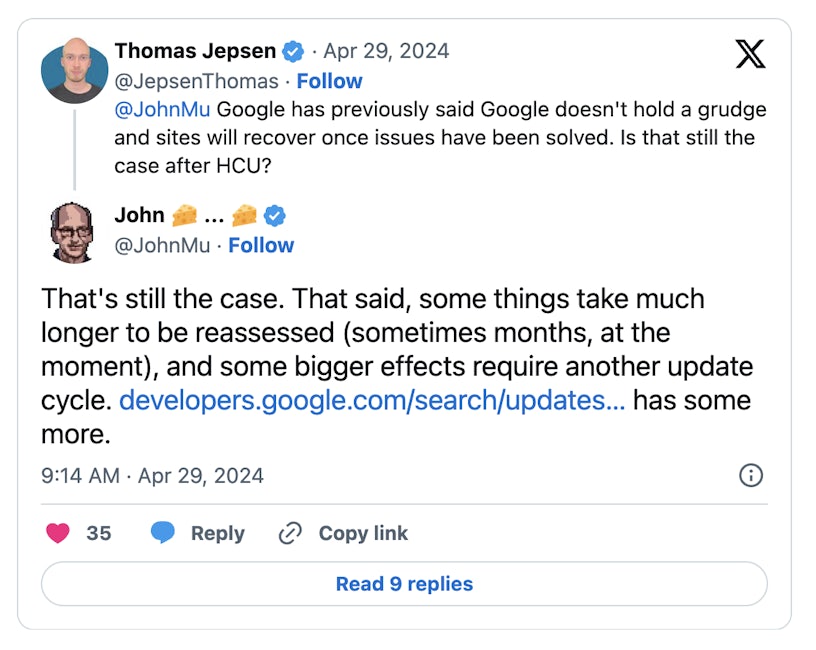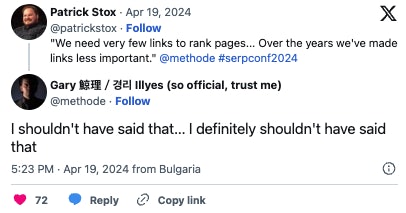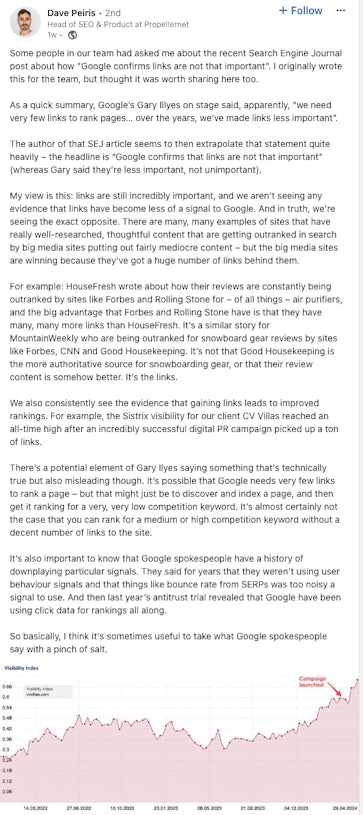This month we bring you some exciting developments and updates from the world of search including new features, SGE updates, industry developments and the effect of the March 2024 Core Update.
Firstly, Google officially concluded the rollout of the March 2024 Core Update on 19th April, making it one of the longest core updates ever rolled out. As we reported last month, this coincided with the release of the Spam Updates, where we saw many, including legitimate websites, penalised as a result.
Google has also made further changes and updates to ranking drop documentation which aims to give advice following these updates for websites which have been negatively affected as a result. They have also made some debatable statements that suggest that links may not be as important as once thought.
In addition to these updates, Google has continued to test its SGE platform, suggesting its intentions to take over the online retail space. We’ll take a closer look at the impacts this poses for e-commerce sites by providing a summary of an interesting study carried out by Onely.
Allow our traffic light system to guide you to the articles that need your attention, so watch out for Red light updates as they’re major changes that will need you to take action, whereas amber updates may make you think and are definitely worth knowing but aren’t urgent. And finally, green light updates which are great for your SEO and site knowledge but are less significant than others
Keen to know more about any of these changes and what they mean for your SEO? Get in touch or visit our SEO agency page to find out how we can help.
In this post, we’ll explore:
- Google March 2024 core update officially completed
- What did this core update target?
- The effects of the core update
- Google’s John Mueller on website recovery after core updates
- Big update to Google’s ranking drop documentation
- Google further postpones third-party cookie deprecation in Chrome
- Why is this important?
- Google confirms links are not that important
- SGE: How Google wants to take over online retail
- What does this mean?
- OpenAI to show content & links in response to queries
Google has officially concluded its March 2024 Core Update after a period of ranking volatility. However, Google’s confirmation of the update’s completion on its data anomaly page came a week later than the actual conclusion, leaving the SEO community speculating.
The core algorithm update, which was announced on March 5, lasted until April 19, taking a total of 45 days to roll out. This update was one of the largest and most complex updates ever released by Google due to the multiple core systems involved. As a result, this led to more significant fluctuations in rankings as the different systems were updated.
What did this core update target?
With the influx of content created by generative AI, this update sought to reduce spammy content, by over 40% to be precise. Google is now treating “low quality” spam with the same severity as pure spam.
As well as addressing spammy content, this update also looked to target link spam, including creating low-value content for manipulative links and repurposing expired domains with drastically different content.
The core update marked a shift in Google’s ranking criteria, reducing the importance of links and emphasising quality, credibility, and substantive content. Google’s spam policies no longer designate links as “important” but merely as “a factor.”
The effects of the core update
The aftermath of the update was palpable, with some websites experiencing losses of over 60% in organic search traffic. Additionally, hundreds of sites were deindexed for allegedly violating Google’s guidelines. It has been suggested that if you were negatively impacted by the Helpful Content Update back in September 2023, you were likely to have felt further impact by this one.
An interesting report and analysis carried out by Eric Lancheres found that affiliate websites were impacted the most despite having high-quality content. This led him to believe that having good articles and content strategy may no longer be enough. Instead, these should be supported with other on-page SEO strategies including internal link building and targeting the keywords which aim to keep users on your website.
Further findings in the report highlighted that local, e-commerce and resource websites were not impacted by the update. Most interestingly, it was suggested that websites with a large social media presence and following appeared to thrive during the update.
With the update finally complete, SEOs and website owners are urged to audit their strategies and websites to align with Google’s new ranking perspective.
John Mueller, a Google Search Advocate, recently addressed concerns raised by SEO professional Thomas Jepsen regarding the impact of recent search algorithm updates. Jepsen asked if sites affected by the updates would recover once issues were resolved:

Mueller reiterated Google’s stance that it doesn’t hold grudges against sites and that recovery is possible. However, he acknowledged that reassessment of rankings could take months, and significant effects might require another update cycle.
He referenced a Google help document explaining that improvements made by site owners aren’t a guarantee of recovery and highlighted the role of broad core updates in influencing recovery.
Further discussion ensued regarding the recovery process for sites affected by recent updates, with Mueller emphasising that recovery depends on individual situations and can require significant time and effort.
Industry figure Lily Ray expressed frustrations about sites experiencing further declines despite making improvements, highlighting the challenges faced by impacted websites:
“…many HCU-affected websites – which have been making all kinds of improvements over the last 7 months – have only seen further declines with the March Core Update.
I have seen some sites lose 90% or more of their SEO visibility since the HCU, with the last few weeks being the nail in the coffin, despite making significant improvements.”
Following the rollout of the March 2024 update, many sites were negatively impacted, despite their best efforts to improve low-quality content, fix technical issues and follow Google’s guidelines. This highlights that clear guidance from Google on recovering from core updates is essential.
The key takeaway from Mueller’s comments:
- Regaining previous rankings after an algorithm hit is possible if sufficient content/site quality improvements are made.
- Recovery timelines can vary significantly and may require a future core algorithm update.
- Even with enhancements, recovery isn’t guaranteed as rankings depend on the overall pool of competing content.
In April, Google updated its documentation on diagnosing ranking drops, introducing five key changes aimed at improving the process. We’ll take a closer look at each of these below.
Change 1: Downplays fixing traffic drops
Previously, the documentation stated that traffic drops can be reversed, however, identifying the reason for these drops is not always straightforward. The new guidance has removed reference to the fact that traffic drops can be reversed and instead now reads:
“A drop in organic Search traffic can happen for several reasons, and it may not be straightforward to understand what exactly happened to your site.”
Change 2: Security or spam issues
Google has also updated its traffic graph illustrations so that they highlight the causes for each kind of traffic decline. This now better reflects the fact that algorithmic changes and manual actions are not technical issues. The document now reads:
“Large drop from an algorithmic update, site-wide security or spam issue”
Change 3: Technical issues
There has also been another change made to the graph label to make it more accurate. Previously the graph label referenced “page-level” technical issues, whereas it now reads:
“Technical issue across your site, changing interests”
“Changing interests” includes market changes and product changes e.g. product trends and new product launches which make previous products less desirable.
Change 4: New guidance for algorithmic changes
Google has also combined two smaller sections, introducing a new section which covers algorithmic changes including guidance for small and large drops in position. This guidance now reads:
“A small drop in position is when there’s a small shift in position in the top results (for example, dropping from position 2 to 4 for a search query). In Search Console, you might see a noticeable drop in traffic without a big change in impressions.
Small fluctuations in position can happen at any time (including moving back up in position, without you needing to do anything). In fact, we recommend avoiding making radical changes if your page is already performing well.”
And for large drops in position:
“A large drop in position is when you see a notable drop out of the top results for a wide range of terms (for example, dropping from the top 10 results to position 29).
In cases like this, self-assess your whole website overall (not just individual pages) to make sure it’s helpful, reliable and people-first. If you’ve made changes to your site, it may take time to see an effect: some changes can take effect in a few days, while others could take several months. For example, it may take months before our systems determine that a site is now producing helpful content in the long term. In general, you’ll likely want to wait a few weeks to analyse your site in Search Console again to see if your efforts had a beneficial effect on ranking position.
Keep in mind that there’s no guarantee that changes you make to your website will result in noticeable impact in search results. If there’s more deserving content, it will continue to rank well with our systems.”
Change 5: Trivial changes
Finally, Google has made some more trivial changes which in comparison may seem insignificant, however, these changes do make the documentation more precise. One of which was a change of headings from:
“You recently moved your site” to “Site moves and migrations”
Google, in its quarterly joint report with the UK’s Competition and Markets Authority (CMA), announced another delay to its plan of removing third-party cookies from its Chrome web browser. Originally, they aimed to finish phasing out third-party cookies by the end of Q4, but due to ongoing challenges and feedback from the industry, regulators, and developers, they’ve had to push back the deadline again.
Why is this important?
Well, third-party cookies are used by advertisers to track a user’s activity across different websites. Google wants to get rid of them to give people more privacy online. But these delays mean digital publishers and advertisers who rely on these cookies to understand what users are doing might face some big changes.
Some groups worry that if cross-site tracking is restricted, websites might resort to less transparent ways to collect your data without you knowing, which could be bad for privacy.
At the end of April, during a conference, Gary Illyes from Google suggested that links are not as crucial for SEO as they used to be. Historically, links were important for SEO as having lots of high-quality links pointing to a website could enhance the site’s trustworthiness and importance. Plus, the anchor text of those links could be used to provide additional information and make it easier for the search engine to contextualise the page.
However, at the conference, Illyes said that nowadays, websites don’t need as many links to rank well in search results. Instead, Google’s machine learning and use of AI have made it easier for the search engine to understand web pages without the need for these links. For this reason, Google is placing less emphasis on links when it comes to ranking factors. On X, Illyes seemingly backtracked on his statement.


This caused a bit of a stir in online discussions. Some people pointed out that Google has made contradictory remarks before about what it says about how it ranks websites. During Google’s Antitrust Trial, it was revealed that some factors Google claimed weren’t important actually were. So, some SEOs advise taking Google’s statements with a pinch of salt.
The debate continues over just how much links affect a website’s ranking. On one side, Google is likely to be able to understand web pages without relying so heavily on links. On the other side, relevant links from other reputable websites can still show Google that a site is trustworthy and has expertise in its field (key factors of E-E-A-T). As a rule of thumb, it’s a good idea to try to get links from other sites that are relevant and have a good reputation when you can.
Need help acquiring links? Enquire about our Digital PR and Content Services.
For the past year, Google has been testing something called the Search Generative Experience (SGE), a tool that marks the search engine’s transition towards artificial intelligence. This feature aims to provide users with quick summaries of information at the top of the search results, without needing to click through to a website, and was rolled out as AI Overviews on 14th May 2024.
Within AI Overviews, if you search for “When was Big Ben built,” instead of having to visit a website, Google will show you a summary right at the top of the search results. Similarly, if you search for a more commercial term like “running shoes,” Google might show you a carousel of different running shoes you can buy, making the research and buying process easier than ever.
However, it’s not entirely clear how Google decides which information to show in these summaries. A study by Onely found that almost half of the sources used in SGE summaries during testing didn’t show up in Google’s organic search results. But it also found that if a website was already in the top 10 search results, it had a better chance of being included in the SGE.
Other key findings from this study include:
- 90% of e-commerce queries returned a SGE result
- SGE favours faster websites as they cost less to load
- SGE is likely to replace feature snippets
- Over 70% of e-commerce SGE results feature a YouTube video
- Typically, Google references five sources for each SGE result
What does this mean?
If you rely on featured snippets or provide easy-to-answer information, you might need to adjust your strategy because SGE could become the new way people get their quick answers. For e-commerce sites, it’s important to focus on creating listings with lots of unique photos and videos to stand out in SGE results.
Even with this shift, sticking to the basics of SEO is still important. Make sure your content matches what people are searching for, covers the whole user journey, and is easy to read and understand.
OpenAI has struck a content licensing deal with the Financial Times. This means that OpenAI will be able to access the global news site’s content to train and improve its language models. Users will now see quotes and links to the Financial Times alongside summaries based on its content. This move, although currently exclusive to the Financial Times, reflects OpenAI’s exploration of new content delivery methods.
This approach involves displaying quotes and linking to content, hinting at ChatGPT’s potential evolution into a search-like tool. In related news, eager-eyed Twitter users have noticed that ChatGPT has added the subdomain: search.chatgpt.com which suggests progress in this direction.

What does this mean for SEO?
This agreement could be the start of ChatGPT becoming a significant source of traffic by linking to websites and offering direct quotes. It underscores the significance of producing high-quality, informative content that is worthy of being linked to.
However, there are uncertainties about which content will be displayed and whether publishers can opt-out. This remains a hot topic and we will keep you updated as the situation unfolds.
Keep up-to-date with our dedicated algorithm and search industry round-ups. For any further information about these posts, or to learn how we can support you, get in touch today.









